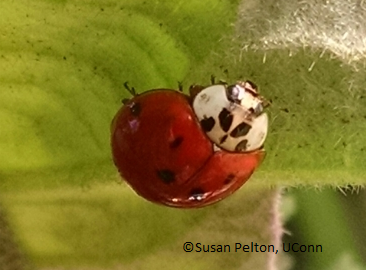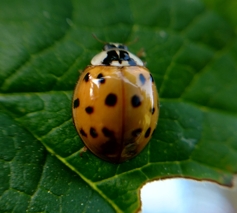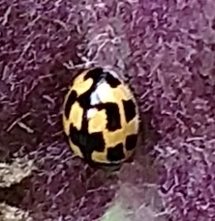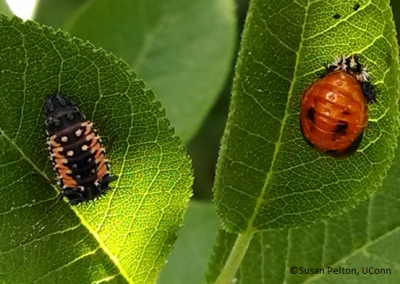Harmonia axyridis

Harmonia axyridis is a beetle from the family Coccinellidae, small beetles ranging from 1/3 to 2/3" with a wide range of colors and various numbers of spots are characteristic for these lady beetles. They can be pale yellow, brown, bright orange red, black or mustard in color.



The spots can number from zero to 20. In the United States, the most common H. axyridis is mustard to red with 16 or more black spots. It can have twin, white, football-shaped markings behind the head which can also be described as white with a black "m" shape. Adult beetles are oval and usually 1/4" long and 3/16" wide, but their size can vary. They have black legs, heads and antennae. Eggs are yellow elongated ovals, laid upright in clusters of about 20, usually on the underside of leaves. The larvae go through 4 instar stages before the pre-adult pupal stage. The fourth instar larvae are elongated, covered with minute spines, and bear little resemblance to the adult. The life cycle takes 3-4 weeks and there are multiple generations in a year.

H. axyridis is commonly called the harlequin ladybird, multicolored Asian lady beetle, the Halloween lady beetle, the Japanese lady beetle or the Asian ladybug/beetle. Not a true bug (which have sucking/piercing mouthparts), the H. axyridis has mouthparts similar to those of grasshoppers. These consist of mandibles that move horizontally to grasp, crush, or cut food.
Now established in the East, South and Northwest, the current H. axyridis is descended from beetles that entered New Orleans and Seattle on ships. Imported beetles were released in California, Georgia and other parts of the South, East and Northwest as a biological control for aphids. This lady beetle has contributed to biological control efforts, especially of pecan aphids and soybean aphids. It also eats more than 50 species of other aphids and soft-bodied insects that are pests of ornamental rose, crepe myrtle, plum, peach, apple, magnolia, clover, cabbage, vetch, pine, tulip tree, maple and other plants.
Once the first killing frost hits in autumn, H. axyridis overwinters in trees, leaf litter, logs or other protected areas. While looking for overwintering sites, it tends to cluster in hundreds or thousands on rocks, houses or other structures. It favors light colors and sunny, southwest exposures. It usually leaves on its own in a few days or weeks. Many Connecticut residents become alarmed when large numbers of lady beetles aggregate on their homes in the fall. When warm spring weather arrives, some people find the same beetles inside and outside their houses.
Controls
These lady beetles, although beneficial insects, sometimes become a nuisance to homeowners. A homeowner can exclude the lady beetles by screening (20 mesh maximum) windows, doors and exhaust vents. Weather-stripping or caulking can be applied to cracks and openings outside the house. These methods are the best lines of defense. Dark colors, which are least attractive to the beetles, can be chosen when exterior repainting is done.
There is no perfect method to get rid of lady beetles that make their way indoors. They can be encouraged to fly outside through an open window. Lady beetles can be swept up with a broom or soft brush and dustpan and placed in covered containers in the refrigerator. Bring them out once a week to warm up and sip sugar water. This will not harm the beetle as they naturally become dormant in cooler weather and return to activity when temperatures reach 50º. H. axyridis may be released outside in warmer weather, away from homes, near a source of food (such as aphids) or in a greenhouse.
A vacuum cleaner crevice tool can be used to get rid of H. axyridis although this method sometimes kills the lady beetles. The dead beetles, if allowed to accumulate in the vacuum cleaner bag for several days, may cause an odor. If the beetles remain alive, they may escape from the cleaner into the house. In either case, the homeowner is advised to seal the bag tightly and dispose of it as soon as the vacuuming is complete. A piece of cloth may be put over the nozzle to collect the lady beetles alive; then they may be released as advised above.
Research is underway to determine if these lady beetles release a scent that attracts more beetles. Scientists have found what may be an aggregation pheromone present in H. axyridis. Now they are trying to discover if non-aggregating lady beetles possess this chemical as well.
Handled lady beetles exhibit a stress-related defensive behavior by secreting a drop of blood out the joints of the legs. This blood can stain walls and fabric, has a foul odor, and can sometimes cause an allergic reaction in humans.
Populations are expected to remain high indefinitely. The lady beetles do have a few natural enemies. North Carolina research has shown the lady beetle to be parasitized by a tachinid fly. A wasp in the Braconid family is another enemy of H. axyridis.
Spraying with an insecticide or killing by another method is NOT recommended for H. axyridis because they are beneficial to agriculture and horticulture. These lady beetles are not poisonous or carriers of human disease. They will not feed on wood, clothing, carpets, draperies or human food. They do not reproduce indoors. Home gardeners are encouraged to put up with this nuisance in their homes, because they may find H. axyridis eating harmful aphids on their garden plants in the summer.
Despite good cultural practices, pests and diseases at times may appear. Chemical control should be used only after all other methods have failed.
For pesticide information or other questions please call toll free: 877-486-6271.
Revised by UConn Home and Garden Education Center 2019.